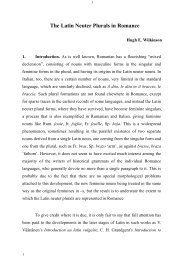THE STRONG PERFECTS IN THE ROMANCE ... - Page ON
THE STRONG PERFECTS IN THE ROMANCE ... - Page ON
THE STRONG PERFECTS IN THE ROMANCE ... - Page ON
Create successful ePaper yourself
Turn your PDF publications into a flip-book with our unique Google optimized e-Paper software.
Besides this group of verbs in which -vi was added to a long<br />
vowel, there was another group, the one with which we are here<br />
concerned, in which -ui is found added to a consonant. In origin, this<br />
-ui seems to have been the same as the -vi of nōvi, -plēvi etc., but<br />
whereas in the above cases the -w- element was added to a<br />
monosyllabic stem with a long vowel, in this case it was added to<br />
disyllabic stems ending in a short vowel. Thus the -ui of the perfects<br />
secui, domui, habui, tacui comes from *-ə-wai (with IE reduced grade<br />
of the root), just as the -(ĭ)tus of the participles comes from *-ə-tos.<br />
Though I can find no parallels to this quoted from other languages, it<br />
seems reasonable to me to suppose that this -w- was added in the<br />
same way to forms 1 and 3 of the perfect, especially when we consider<br />
that -plē(v)-, (g)nō(v)-, strā(v)-, trī(v)-, fū(v)- are originally disyllabic<br />
stems (Buck, §§126-7), and that the stem of the imperfectum of this<br />
second group of verbs often ends in a long vowel (IE strong grade of<br />
the root), as secā-, domā-, habē-, tacē-. As we have just seen, some or<br />
all of the -vi perfects from roots ending in -v-, such as mōvi, iūvi, lāvi,<br />
probably belong here, though they can also be explained in the same<br />
way as cāvi above; if they go back to forms like *mowə-wai, or were<br />
formed at a later stage by adding -ui (extracted from sec-ui, dom-ui<br />
etc.) to the root, then they are to be analysed as mov-vi, iuv-vi, lav-vi.<br />
(Forms in -ui among the -āre verbs, like secui, domui, disappeared,<br />
though fossilised traces of the corresponding participles in -ĭtus<br />
remained; see my previous paper.) Lavā- is clearly a disyllabic stem<br />
(cf. Gk. ló(w)e-ssa), and because of this Burger, as quoted approvingly<br />
by Bonfante, says lāvisti, mōvisti should be divided lāvi-sti, mōvi-sti,<br />
but such disyllabic stems with a long vowel in the first syllable cannot<br />
be traced back to IE, so I prefer the *-ə-wai interpretation. In this case<br />
the first vowels of lāvi and mōvi would only be what is commonly<br />
8









